 Image search results - "hadaka" Image search results - "hadaka" |

At 2 pm, the 18 portable shrines gather at the Ohara Fishing Port. 大原漁港に参集
|
|

They run around while carrying a portable shrine.
|
|
|

They keep going round and round. Quite rowdy.
|
|
|
|

A man who got bumped and fell is quickly brought to his feet by other people.
|
|

Nice mikoshi.
|
|

One thing unusual about this festival is that they carry the mikoshi with their hands and arms only, and not on their shoulders.
|
|

Tossing a portable shrine, a common sight during the festival.
|
|
|

A group of men carry a red and white pole in front of Inazawa Station, on their way to Konomiya Shrine.
|
|

This is where they offload fish.
|
|

Raising a pole in front of Inazawa Station
|
|

Ohara beach where the portable shrines will be carried into the ocean. 大原海水浴場
|
|

Raising a pole in front of Inazawa Station
|
|

Ohara beach
|
|
|
|

A few photographers come early to secure the best positions.
|
|

They zig-zag along the street, and they are filled with sake.
|
|

They are soon followed by many more photographers.
|
|
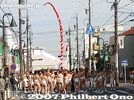
Every once in a while, they raise their pole.
|
|

The crowd at the beach.
|
|
|

At 3 pm, the first portable shrine is carried into the ocean. 汐ふみ(大原海水浴場)
|
|

On the straight road from Inazawa Station to Konomiya Shrine.
|
|

Portable shrines from 18 shrines in the area join in the festival.
|
|
|

Ohara Hadaka Matsuri
|
|
|
|
|
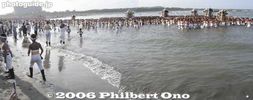
Many more portable shrines follow.
|
|

Konomiya Shrine torii and the long path to the shrine is lined with a large crowd.
|
|

Numerous groups of near-naked men (no women) proceed to the shrine all afternoon.
|
|
|
|
|

Zig-zag to the shrine
|
|
|
|
|

Another torii
|
|
|
|

Ohara Hadaka Festival
|
|
|
|
|

Romon Gate 楼門
|
|
|

After passing through this gate, the men enter the shrine grounds. Romon Gate 楼門
|
|

This photographer forgot his shorts.
|
|

Haiden Hall where the men offer their long poles. 拝殿
|
|
|

Haiden Hall 拝殿
|
|

Gas station
|
|

Now empty, this path will soon be filled with thousands of men in loincloths.
|
|

Exhibition space
|
|

Some of the men tear off strips from their handband and give them to bystanders.
|
|
|

Gaijin talking to gaijin. Sounded Australian. English teacher at junior high.
|
|

Taking a break.
|
|

Gaijin girls had an easy time attracting men who happily tried to converse in English and bestow cloth strips.
|
|

From the beach, the portable shrines are paraded in town.
|
|

The inner path to the shrine gets more crowded.
|
|

Also at night.
|
|

It was a pretty cold day, and these men were drinking all afternoon.
|
|

Festival poster for Sept. 23-24, 2004.
|
|
|
|

Banzai cheers when an extra-large pole was brought to the shrine.
|
|

Stacking up the poles.
|
|

Men start to pour into the shrine.
|
|

They are waiting for the Sacred Man.
|
|

Now they start to splash cold water on the men, and some of the spectators.
|
|
|

Water supply
|
|
|

Splashing water
|
|

Men with buckets come for a refill.
|
|
|

They get pretty crazy, getting more water.
|
|
|
|
|

Konomiya Hadaka Festival, Inazawa, Aichi Pref.
|
|
|

All the men look in the direction of the Sacred Man.
|
|

All the men look in the direction of the Sacred Man, but few can actually see him or touch him for good luck.
|
|

The Sacred Man struggles to reach the small window.
|
|

The men are shouting "Kami-o Kami-o" (another way of pronouncing the kanji for Kami-otoko). 神男
|
|
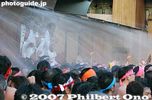
This is the small window the Sacred Man has to enter. It has a sprinkler system.
|
|
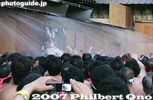
All the men want to touch the Sacred Man, believing that it will dispel bad luck.
|
|

The men in the window give directions to the Sacred Man.
|
|

Sometimes a man from the window jumps into the crowd to grab and take in the Sacred Man.
|
|
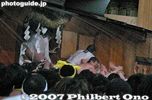
Maybe this is the Sacred Man being pulled into the window.
|
|

When the Sacred Man enters the window, everyone cheers.
|
|

The festival is over.
|
|

The window where the Sacred Man entered.
|
|

Inside the shrine hall.
|
|

TV reporter with this year's Sacred Man (Kami-otoko), Kato Norihiko, from Ichinomiya 神男:加藤 典彦
|
|

TV reporter with this year's Sacred Man (Kami-otoko), Kato Norihiko 神男:加藤 典彦
|
|

Giant kagami mochi, rice cake in the Haiden Hall. Over 2 meters tall and over 2 meters diameter. Weighs 4 tons. They are to be cut into small pieces (with a chain saw) and given away the next morning.
|
|

More giant mochi offered to the shrine. Notice the forklift. 大鏡餅奉納
|
|

Giant mochi inside the Haiden hall. 大鏡餅奉納
|
|

Closeup of giant mochi. Solid as a rock.
|
|

Mud Paddy. Main site of the Warabi Hadaka Matsuri held every Feb. 25.
|
|

Mimusubi Shrine, Yotsukaido, Chiba. The small shrine that conducts the festival. (皇産霊神社)
|
|

Baby Blessings at Warabi Hadaka Matsuri in Yotsukaido, Chiba. Infants are blessed in front of the shrine.
|
|

Men Take Strands of Straw
|
|

A Man and a Baby at Warabi Hadaka Matsuri in Yotsukaido, Chiba.
|
|

Babies to Mud at Warabi Hadaka Matsuri in Yotsukaido, Chiba. The men carry babies to the mud paddy and use a straw strand to paint a dot on the baby. Sometimes they use a finger to do it.
|
|
|
|

Sacred Water (and Mud). On the the left, the water feeding the paddy is enclosed by a sacred rope. This makes the water (and mud) sacred.
|
|

All the baby-carrying men must be careful not to slip and fall in the mud. Warabi Hadaka Matsuri in Yotsukaido, Chiba.
|
|

Mud Spotting, Warabi Hadaka Matsuri in Yotsukaido, Chiba. The men hold babies and use mud to paint a mud spot on the baby's face. It is to wish for happiness for the baby.
|
|

Some babies wear beautiful kimono for the occasion.
|
|

The festival is also nicknamed "Doronko Matsuri" which means Mud Festival.
|
|

Mud Fight
|
|

Keep in mind that this is in the middle of winter.
|
|
|

Mud Fight. After clashing and crashing to the mud, they throw mud at each other.
|
|

They are in the mud for only a few minutes. Then they go back up to the shrine nearby and warm up near a fire. They go back and forth between the shrine and mud paddy about 4 or 5 times.
|
|

A Touch of Mud. One custom is to receive a touch of mud on your face.
|
|

Mud for All Ages
|
|

Mud Brings Happiness, at Warabi Hadaka Matsuri in Yotsukaido, Chiba.
|
|

New Status Symbol at Warabi Hadaka Matsuri in Yotsukaido, Chiba.
|
|

Mud on Your Face: Fashionable, at Warabi Hadaka Matsuri in Yotsukaido, Chiba.
|
|

After warming up at the fire, they run back to the mud.
|
|

Mud Fight Round 2
|
|
|
|
|

Mud Slinging
|
|
|
|
|

I can't see... That's what he said: "Mienai" The kids nearby were screaming with laughter.
|
|
|

Warm Up
|
|
|
|

The End(s)
|
|

Being next to the Pacific Ocean, Chiba has quite a few festivals held on the beach. The Kazusa Junisha Matsuri is one of the larger ones. Sept. 13, 2009 (Sun.) was the main festival day when they went in the water at the beach.
|
|

The day starts with a Shinto ceremony at 10 am at Tamasaki Shrine, near Kazusa-Ichinomiya Station on the JR Sotobo Line. 玉前神社
|
|

Tamasaki Shrine is crowded with people as a ceremony still goes on. The Kazusa Junisha Matsuri started in 807. It is designated as Chiba Prefecture's Intangible Cultural Property.
|
|

Two portable shrines in front of the Kaguraden stage. Kazusa is the name of the former province in central Chiba Prefecture. Junisha means twelve shrines.
|
|

Sacred dance at the Kaguraden by Sarutahiko.
|
|

Tamasaki Shrine torii
|
|

The girls had their hair airbrushed with colorful designs. I've noticed that women and girls participating in matsuri have become quite fashionable, chic, or hip.
|
|

Girls were originally not allowed to participate in the festival, but now they do even though it is a hadaka (nude) festival. Of course, no one is really naked.
|
|

Sacred horse
|
|

One of the child horse riders.
|
|

Child horse rider sits on a bunch of soft cushions on the horse.
|
|
|

A procession departs Tamasaki Shrine at 1 pm, led by Sarutahiko.
|
|

The beginning of the procession consists of a few portable shrines pulled by children.
|
|
|
|
|

The sacred horse and child riders soon join the procession as they leave Tamasaki Shrine.
|
|

Child rider leaving Tamasaki Shrine.
|
|

Leaving Tamasaki Shrine. It was impossible to judge where I should be to take good shots. I missed quite a few opportunities. I have to see the festival again to take the shots I wanted to take this time.
|
|

Back at Tamasaki Shrine are two other portable shrines which had arrived from Sannomiya Shrine, one of the junisha (12 shrines) in the Kazusa area.
|
|

The portable shrines begin to leave Tamasaki Shrine.
|
|

A portable shrine leaves Tamasaki Shrine.
|
|

They then ran with the portable shrine. They will run while carrying the shrine to the beach several kilometers away.
|
|

The beach is too far to walk, so they provided free shuttle buses to the beach from Kazusa-Ichinomiya Station from 2 pm. It was a 10-15 min. ride to the beach.
|
|

On Kujukuri Beach, there a stretch of beach called Tsurigasaki Kaigan Beach marked by a torii. This will be the Tokyo 2020 Olympic venue for surfing.
|
|

Tsurigasaki Kaigan beach is where they believe the gods arrive. 釣ケ先海岸
|
|

Tsurigasaki Kaigan is where the horses and portable shrines will start to arrive at 2:30 pm to 3 pm. This is where the crowd is. But the beach is big enough for all of us.
|
|

On the beach. Good spot for surfing as well.
|
|

One child horse rider arrives.
|
|

One great thing about this hadaka matsuri is that there are women as well. Most hadaka matsuri have only men.
|
|

The mikoshi arrive on the beach.
|
|
|

They give a few cheers before they started running on the beach.
|
|

Here they come.
|
|

Women too, while they are careful to prevent any nip slips.
|
|

They run on the beach while carrying the mikoshi.
|
|

A stampede.
|
|
|
|
|

They head for Tsurigasaki Beach, where the torii is.
|
|

They prop up the mikoshi before carrying it toward the ceremony place.
|
|
|
|
|

The mikoshi start to gather for a ceremony.
|
|

The mikoshi start to gather for a ceremony as they all run at full speed.
|
|
|
|
|

More mikoshi arrive.
|
|

Shrine priest arrive on horseback. He looked very weary. It was a hot day too.
|
|
|
|
|

After the ceremony, they head for the water.
|
|

Very jovial and noisy.
|
|

To the beach and water.
|
|

In the water, maybe ankle deep. But the waves made it knee-deep.
|
|
|

Everyone is yelling and cheering.
|
|
|
|
|
|
|
|

They tossed the mikoshi into the air a few times.
|
|
|
|
|

Back on land.
|
|
|
|
|

Festival girls posing for me. They love the attention.
|
|

Kazusa Junisha Matsuri Festival, Ichinomiya, Chiba on Sept. 13, 2009.
|
|

Women standing by to pull the mikoshi.
|
|
|

Tossing the mikoshi into the air.
|
|

I kept shooting their backs. Next time, I'll try to shoot more faces.
|
|

You could go in front of them to shoot their faces, but the water would be deeper.
|
|

They kept waving their fans and cheering in the water.
|
|
|
|

Great spectacle, especially with women included. Great idea to allow women in the festival.
|
|
|

Returning to land.
|
|

The men covered their bellies, while the women covered their bellies and chests.
|
|

This festival separates the amateur photographers from the pros. Amateurs wear long pants and shoes and enter the ocean to take pictures. I was of course wearing shorts and rubber slippers (but barefoot in the water).
|
|

The next spectacle was them running through the torii on the beach.
|
|

All the mikoshi headed for the torii.
|
|
|
|

First were the horses galloping through. Each horse was guided by two men running alongside.
|
|

The boy looked thrilled to be riding at full speed. Very bumpy though.
|
|
|

Then the mikoshi sped by one after another.
|
|
|

Love these women running and pulling the mikoshi.
|
|

It's amazing that no one tripped and fell.
|
|

More women in fashionable clothing to pull a mikoshi.
|
|
|

They are cheering and shouting throughout.
|
|
|
|
|
|
|
|
|
|
|
|
|
|
|
|

It would take them about an hour to get back to town.
|
|

The sacred horse arrive in town.
|
|

More horses arrive.
|
|
|

Making way for the horses.
|
|

Shrine priest arrives.
|
|
|
|